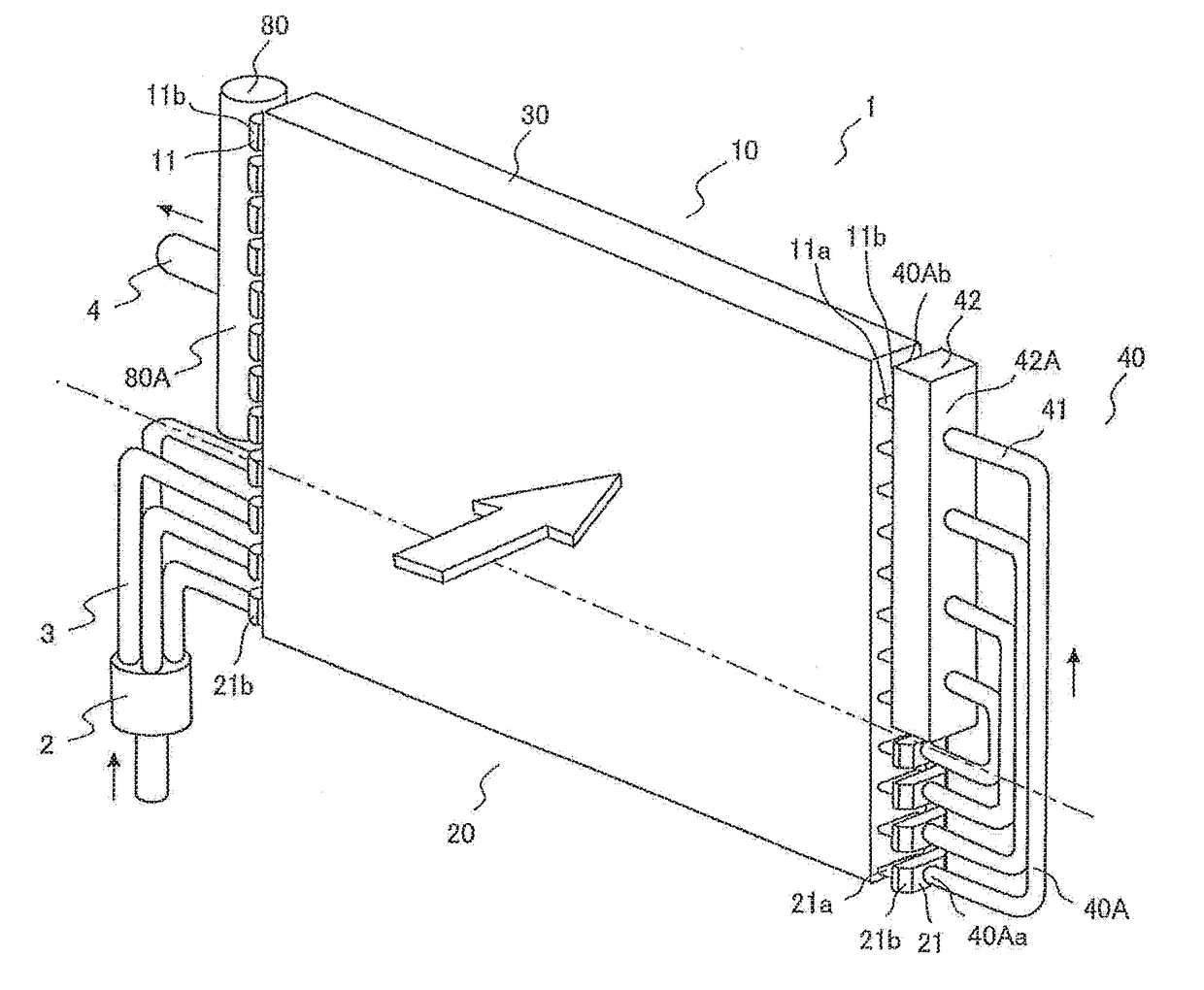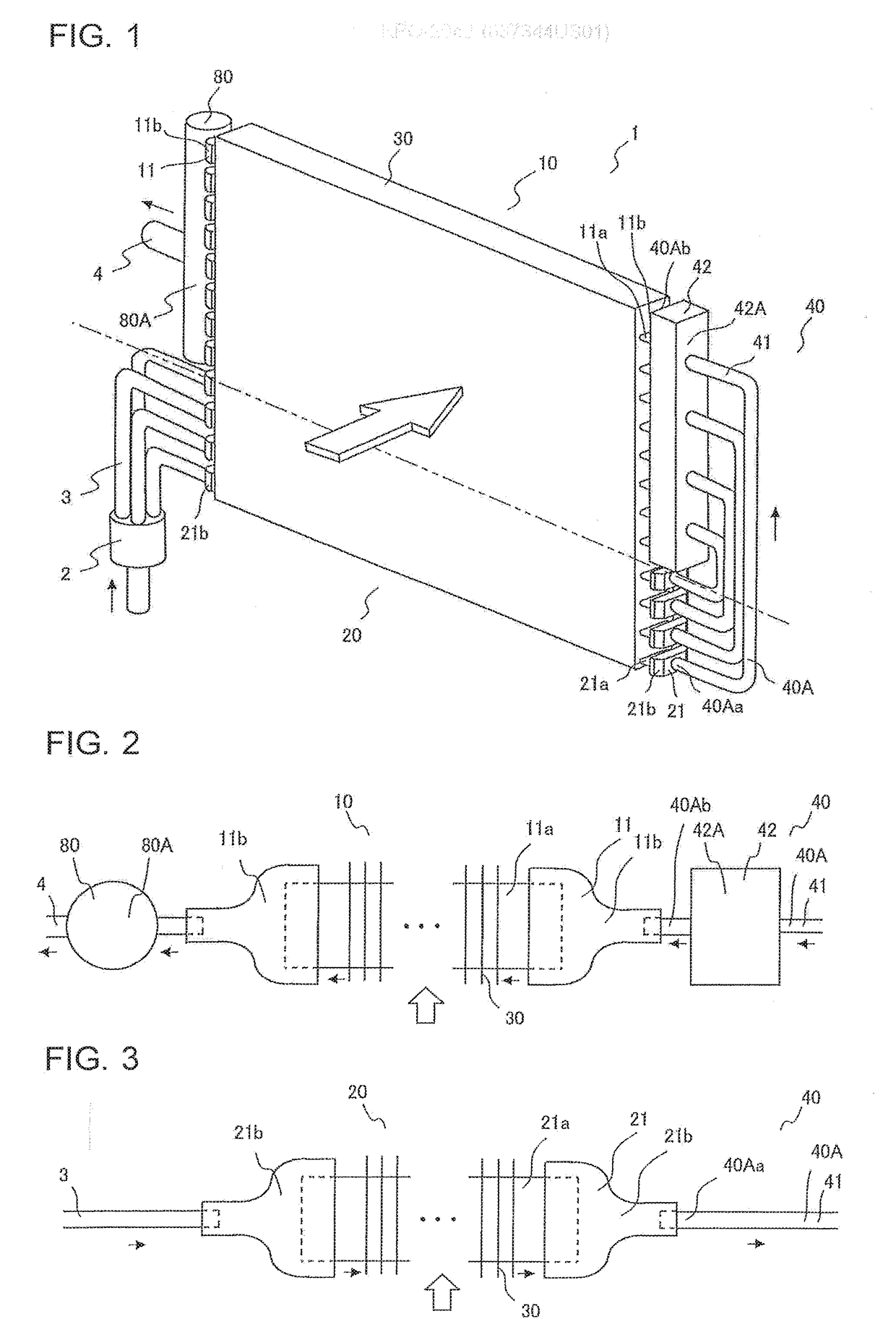Heat exchanger and air-conditioning apparatus
a technology of heat exchanger and air conditioner, which is applied in the direction of indirect heat exchanger, light and heating apparatus, refrigeration components, etc., can solve the problems of reducing the operation efficiency of the refrigeration cycle apparatus and increasing the pressure loss of refrigerant, so as to reduce the discharge temperature, enhance the operation efficiency, and reduce the performance of the heat exchanger
- Summary
- Abstract
- Description
- Claims
- Application Information
AI Technical Summary
Benefits of technology
Problems solved by technology
Method used
Image
Examples
embodiment 1
[0027]A heat exchanger according to Embodiment 1 of the present invention is described.
[0028]FIG. 1 is a perspective view of the heat exchanger according to Embodiment 1. FIG. 2 is a top view of a main heat exchange unit and a part of a relay unit of the heat exchanger according to Embodiment 1. FIG. 3 is a top view of a sub-heat exchange unit and a part of the relay unit of the heat exchanger according to Embodiment 1. In FIG. 1 to FIG. 3, a flow of refrigerant when a heat exchanger 1 acts as an evaporator is indicated by the black arrows. Further, in FIG. 1 to FIG. 3, a flow of air for exchanging heat with the refrigerant in the heat exchanger 1 is indicated by the white arrow.
[0029]As illustrated in FIG. 1 to FIG. 3, the heat exchanger 1 includes a main heat exchange unit 10 and a sub-heat exchange unit 20. The sub-heat exchange unit 20 is located below the main heat exchange unit 10 in the gravity direction. The main heat exchange unit 10 includes a plurality of first heat trans...
embodiment 2
[0059]A heat exchanger according to Embodiment 2 of the present invention is described.
[0060]Overlapping description or similar description to that of Embodiment 1 is appropriately simplified or omitted.
[0061]FIG. 9 is a perspective view of the heat exchanger according to Embodiment 2. In FIG. 9, a flow of refrigerant when a heat exchanger 1 acts as an evaporator is indicated by the black arrows. Further, in FIG. 9, a flow of air for exchanging heat with the refrigerant in the heat exchanger 1 is indicated by the white arrow.
[0062]As illustrated in FIG. 9, the relay unit 40 includes a plurality of pipes 41, and a plurality of distributors 43. Each of the plurality of distributors 43 has an inlet connected to a corresponding one of the pipes 41, and a plurality of outlets connected to corresponding ones of the plurality of pipes 41, to thereby form each of a plurality of relay passages 40A. In other words, the relay passages 40A are formed of the pipes 41 and the distributors 43, wit...
embodiment 3
[0065]A heat exchanger according to Embodiment 3 of the present invention is described.
[0066]Overlapping description or similar description to that of each of Embodiment 1 and Embodiment 2 is appropriately simplified or omitted,
[0067]FIG. 10 is a perspective view of the heat exchanger according to Embodiment 3. In FIG. 10, a flow of refrigerant when a heat exchanger 1 acts as an evaporator is indicated by the black arrows. Further, in FIG. 10, a flow of air for exchanging heat with the refrigerant in the heat exchanger 1 is indicated by the white arrow.
[0068]As illustrated in FIG. 10, a relay unit 40 includes a plurality of pipes 41, a plurality of distributors 43, and a stacking type header 42 including a plurality of branch passages 42A formed in the stacking type header 42. Each of the plurality of distributors 43 has an inlet connected to one pipe 41, and a plurality of outlets connected to corresponding ones of the plurality of pipes 41, and one end of each of the plurality of ...
PUM
 Login to View More
Login to View More Abstract
Description
Claims
Application Information
 Login to View More
Login to View More - R&D
- Intellectual Property
- Life Sciences
- Materials
- Tech Scout
- Unparalleled Data Quality
- Higher Quality Content
- 60% Fewer Hallucinations
Browse by: Latest US Patents, China's latest patents, Technical Efficacy Thesaurus, Application Domain, Technology Topic, Popular Technical Reports.
© 2025 PatSnap. All rights reserved.Legal|Privacy policy|Modern Slavery Act Transparency Statement|Sitemap|About US| Contact US: help@patsnap.com



